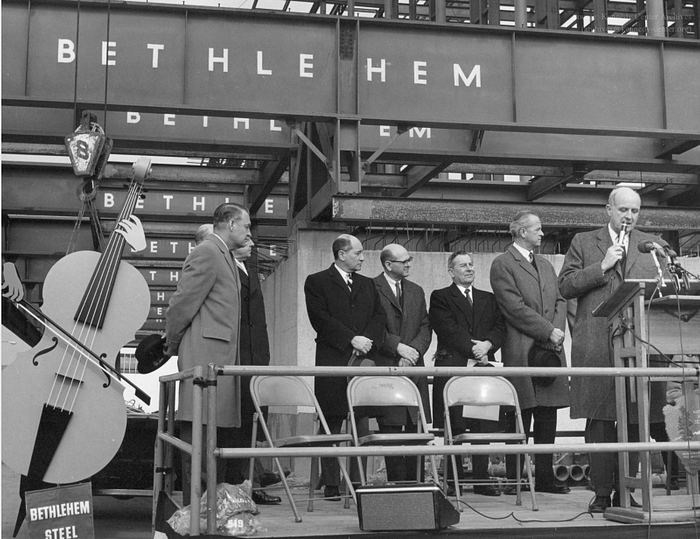On this day in 1964, construction on the Kennedy Center began

For the past five decades, the Kennedy Center has been known for its marble façade and golden pillars, ornate chandeliers and impressive halls. But 57 years ago on this day, none of those existed. Follow along with the Kennedy Center Archives as we explore the journey from the Center’s groundbreaking to completion.
On December 2, 1964 at noon, President Lyndon B. Johnson officially broke ground on the John F. Kennedy Center for the Performing Arts using the same gold-plated spade that Presidents William Taft and Franklin Roosevelt used for the Lincoln and Jefferson Memorials groundbreakings. In an address given during the ceremony, Johnson stated that the Center would be “a living force for the encouragement of art,” focusing on inspiring creativity in young people, serving as a model for other cultural centers in the nation, providing opportunities for artists, and bringing the arts to everyone. He ended: “Yes, this is our ambitious program. But so was the vision of the man in whose memory this Center is today named.”

While the groundbreaking ceremony was a momentous occasion in the history of the Kennedy Center, it was only the first step in a long process of construction. Excavation of the site would not begin until the summer of 1965. By this point, most of the land for the Center had been acquired by the federal government’s National Capital Planning Commission. However, one of the final plots of land needed was the site of the former Heurich Brewing Company, which closed in 1956 but still belonged to the Heurich family. The NCPC’s funds wouldn’t cover the purchase for the entire plot of land, but on June 23, Christian Heurich, Jr. and his sisters Anita Heurich Eckles and Karla Heurich Harrison formally gifted the remaining land to the Kennedy Center, a $150,000 value, in return for a memorial box in the Concert Hall (now Box 30).

Once the land had been completely acquired, construction could begin in earnest. The foundation was dug by contractor John McShain throughout 1966, and Bethlehem Steel provided the materials to begin on the structure itself. In January of that year, the Kennedy Center Board of Trustees officially approved the founding of the Friends of the Kennedy Center, a national volunteer organization dedicated to bringing awareness to and fundraising for the performing arts, even before the Center was completed.

One of the first major projects of Friends was the Tom Sawyer Project, which began with DC students painting colorful murals to decorate the fencing around the construction site. The project soon expanded to asking US states, territories, and foreign embassies to contribute panels painted by children for the site. Each of the 250 panels contributed was 8 feet square and represented 45 states and 28 foreign nations.



In 1968, progress on the steel framing reached major milestones; Bethlehem Steel created two unique decorations for the “topping out” ceremonies that would take place during the year. Topping-out ceremonies celebrate the completion of the steel structure of a building, which was a tradition that usually saw a tree or flag hoisted to the highest point of the steel structure. Instead, the Concert Hall block was topped with an 11-foot tall, 200-pound steel bass viol on January 29, 1968. Several months later, on September 30, 1968, the Eisenhower Theater structure was topped out with large steel drama masks in a ceremony that included performances by the US Navy Band and was attended by Senator Edward Kennedy, Jean Kennedy Smith, and Mayor Walter Washington.


Throughout the process of construction, the Kennedy Center received many gifts from foreign countries, including approximately 3,700 tons of marble from Italy to use for the interior and exterior of the building. The marble was provided by three quarries, including the Bufalini family’s quarry in Carrara, and was transported across the Atlantic Ocean in over a dozen shipments. In this letter from 1963, Roger Stevens thanks the Ambassador to Italy for the nation’s gift to the Center.




Before the building was fully completed, the Friends of the Kennedy Center offered tours of the structure to visitors in what they referred to as “hard hat tours.” These tours took place outside and inside the building, showing off the theaters still missing stages, seats, and even walls. The finishing touches, including foreign gifts of artwork, stage curtains, and chandeliers, were installed in 1970–1971.




The first public use of the Kennedy Center was on May 17, 1971, for a gala fundraiser. The goal of this benefit, which featured the Meyer Davis Orchestra, was to raise money for the Center’s specially priced ticket program for students, seniors, and patrons with fixed low incomes. A few months later, the acoustics in the Opera House were tested for an audience with a performance of La Traviata by the New York City Opera.




Seven years after the groundbreaking ceremony, the Kennedy Center officially opened with the premiere of Leonard Bernstein’s Mass: A Theatre Piece for Singers, Players and Dancers on September 8, 1971, in the Opera House. The production was commissioned by former First Lady Jacqueline Kennedy for the opening and featured over 200 performers, onstage musicians and choirs, and choreography by Alvin Ailey. For a closer look at the myriad performances that have graced Kennedy Center stages in the decades since, as well as the connection between the Center and the land on which it’s built, check out the online galleries for the free, year-long, exhibit If These Halls Could Talk, which celebrates the Center’s 50th anniversary season through the people who have brought it to life.

Do you have a story about the Kennedy Center you’d like to share with the archives for our 50th anniversary season? Tell us about it.

